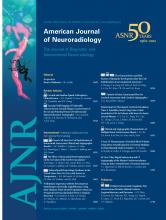Research ArticleNeurointervention
Analysis of Intra-Aneurysmal Flow for Cerebral Aneurysms with Cerebral Angiography
L.-D. Jou and M.E. Mawad
American Journal of Neuroradiology October 2012, 33 (9) 1679-1684; DOI: https://doi.org/10.3174/ajnr.A3057
L.-D. Jou
aFrom the Department of Radiology, Baylor College of Medicine, Houston, Texas.
M.E. Mawad
aFrom the Department of Radiology, Baylor College of Medicine, Houston, Texas.

References
- 1.↵
- Ferguson GG
- 2.↵
- Kulcsar Z,
- Ugron A,
- Marosfo IM,
- et al
- 3.↵
- Xiang J,
- Natarajan SK,
- Tremmel M,
- et al
- 4.↵
- 5.↵
- Cebral JR,
- Mut F,
- Weir J,
- et al
- 6.↵
- Steinman DA,
- Milner JS,
- Norley CJ,
- et al
- 7.↵
- 8.↵
- Meckel S,
- Stalder AF,
- Santini F,
- et al
- 9.↵
- Ionita CN,
- Wang W,
- Bednarek DR,
- et al
- 10.↵
- Sadasivan C,
- Lieber BB,
- Cesar L,
- et al
- 11.↵
- Tenjin H,
- Asakura F,
- Nakahara Y,
- et al
- 12.↵
- Gockenbach MS
- 13.↵
- Taylor GI
- 14.↵
- Lantz BM,
- Foerster JM,
- Link DP,
- et al
- 15.↵
- Mantha AR,
- Benndorf G,
- Hernandez A,
- et al
- 16.↵
- 17.↵
- 18.↵
- 19.↵
- 20.↵
- Hubbell JH
In this issue
Advertisement
L.-D. Jou, M.E. Mawad
Analysis of Intra-Aneurysmal Flow for Cerebral Aneurysms with Cerebral Angiography
American Journal of Neuroradiology Oct 2012, 33 (9) 1679-1684; DOI: 10.3174/ajnr.A3057
0 Responses
Jump to section
Related Articles
Cited By...
This article has not yet been cited by articles in journals that are participating in Crossref Cited-by Linking.
More in this TOC Section
Similar Articles
Advertisement











